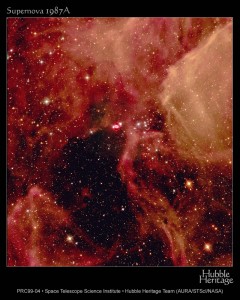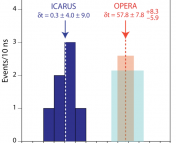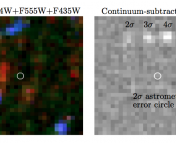
Hubble Heritage image of the SN1987A remnant in the Large Magellanic Cloud (center of image, two small offset rings). (Image from Hubble/STScI)
Yesterday, after rumors surfaced on the Science Insider blog that OPERA’s startling superluminal result had been traced to a faulty cable, the collaboration sent out a press release stating that they had uncovered two previously unaccounted-for errors, one in the interpolation used to synchronize the two clocks at the near and far sites, and one traced to a bad fiber optic cable in the GPS apparatus that had been delaying data. Unlike the rumors, which cited a specific 60 ns delay caused by the bad cable (suspiciously close to the neutrinos’ alleged lead over light), the collaboration themselves did not give any precise numbers for the error introduced by these two sources, although they did note that the two should have pushed the result in opposing directions, i.e. the cable would cause the neutrinos to appear faster, and the clock sync problem would cause the neutrinos to appear slower. Full and final judgement will have to wait until the collaboration publishes an update, and some may reserve their ultimate verdict for the results of independent tests by experiments like Fermilab’s MINOS, but the future looks bleak for the supposed superluminal result.
Not that this is much of a surprise. Extraordinary claims require extraordinary evidence, and OPERA’s was certainly extraordinary. Scientists pored over the original paper as soon as it was published (we covered just one of the more than 100 follow-up papers, and one by the OPERA collaboration themselves), and most believed that at some point a systematic error just like this would eventually surface to explain the discrepancy. Astronomers in particular were skeptical based on an event that, coincidentally, occurred exactly 25 years ago today: the arrival of the neutrino pulse from Supernova 1987A.
SN1987A is the closest supernova ever observed in modern times and still the only one for which we have detected the associated neutrino pulse. It bloomed this night 25 years ago in the Large Magellanic Cloud, where it was spotted with the naked eye at the Las Campanas Observatory in Chile by a telescope operator walking between the domes, as well as by New Zealand amateur astronomer Albert Jones; at the same time, three separate neutrino observatories (Kamiokande II, Baksan, and IMB) detected a sharp pulse of neutrinos at precisely 0735 UTC. All in all, 24 neutrinos were traced to SN1987A, a significant rise over the usual background rate.

The evolution of the SN1987A remnant, showing brightening as outrushing ejecta collides with stationary material. (Image NASA/STScI/CfA/P.Challis)
This was a major triumph for the theory of core-collapse supernovae, which holds that an intense neutrino pulse is necessary to propel the outward-moving shock that creates the explosion, and that the majority of a supernova’s energy is actually carried by neutrinos rather than light. The magnitude of the neutrino flux and its timing relative to the arrival of the light matched well with theory, and it seemed like the core-collapse model had been wholly vindicated. The near-simultaneous arrival of the neutrinos and the light caused astronomers to doubt OPERA decades later, as, if the OPERA reported delay were scaled up across cosmic distances, the neutrinos should have arrived a full four years before the light.

Image of SN1987A, with the "before" image overlaid in negative (black dots). The slightly distorted dot at the center of the bright supernova is Sanduleak -69 202, the progenitor. (Image from Australian Astronomical Observatory)
However, there was more to come. SN1987A was one of the first supernovae for which we could uncover the progenitor, the original star that had exploded, because we had images of the region before the explosion. When the before and after were compared, astronomers traced the supernova to the star Sanduleak -69 202, and got a big surprise: the progenitor was a blue supergiant. At the time it was believed that only red supergiants could create core-collapse supernovae, yet here was clear evidence that this was not true. Since then, many models have been put forth to explain the event – for example, that the star was a binary system that had recently merged, or that it had an unusually low metallicity. As the remnant has evolved, it has presented even more surprises: the appearance of three nested rings of material that have been lighting up as the supernova ejecta collides with them, and the surprising difficulty in locating a remnant neutron star within the debris.
These days SN1987A seems almost quaint. The “A” at the end of its designation indicates that it was the first supernova detected in the year 1987; as of this writing 34 supernovae have already been officially confirmed in the year 2012 and hundreds more likely candidates detected, all much farther away than the Large Magellanic Cloud, and many more will be catalogued before the year is out. Just a few months ago scientists managed to capture supernova PTF11kly (later SN2011fe) within 23 hours of the initial detonation. The neutrino-powered core-collapse model SN1987A validated is an established theory and perhaps, these days, a bit boring; all the cutting-edge weirdness is happening in things like hypernovae and pair-production supernovae.
But SN1987A still reminds us of one important fact: sometimes you’re right, and sometimes you’re wrong. And coupled with OPERA’s mea culpa, it demonstrates the essential back-and-forth of science: extraordinary claims require extraordinary evidence, but if that evidence has been presented, we must change our ideas. The law of lightspeed is ingrained into the foundations of modern physics, a cornerstone of relativity and a conclusion supported by extensive theory, mathematics, and, most importantly, decades of rigorous observations. Scientists were right to be skeptical, and when it came down to it, OPERA’s results didn’t hold up. But when SN1987A proved that a blue supergiant could explode as a core-collapse supernova, astronomers had to go back to their models and change them to account for this possibility. Similarly, if OPERA’s result had held up under scrutiny and been confirmed by independent followups and replications of the experiment (and that is a big fat important if), then – and only then – we would be forced to go back to our whiteboards and have a good long think.
Instead OPERA combed through their potential errors and uncovered a much more mundane source, and admitted their result was wrong. The textbooks will remain un-rewritten, the dramatic headlines will go back in a drawer, and nervous undergrads in relativity class will breathe a sigh of relief. The universe is still the same amount of strange it was yesterday – that is to say, very, but not that strange. Not yet.




Great article Elizabeth! Your reporting on this is significantly more measured and considered than a large fraction of the science blogosphere…
Excellent article. Great to celebrate the celestial event. What happend that star exploded almost 1,70,000 years ago in these 25 years! Curious to know